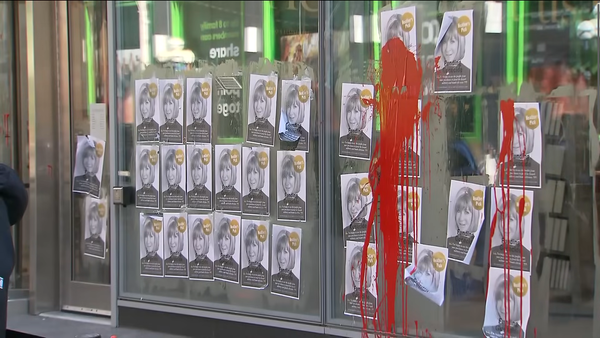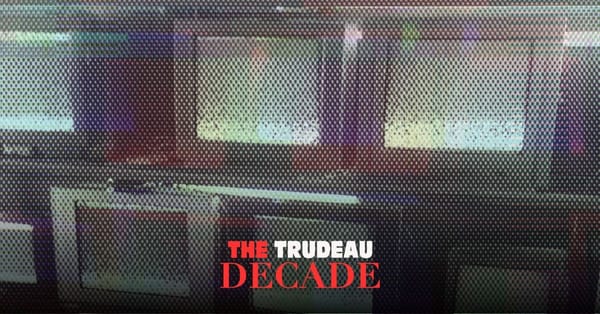I spent a lot of my twenties on a bus. Mostly Greyhound, though there were a few dalliances with Megabus and its Roger Waters concert prop looking mascot hawking fabled $1 rides.
My main route was from Peterborough, Ont., where I went to school, to my hometown of Sault Ste. Marie. With stops and transfers, it was about a 14 to 16 hour trip, just enough time to forget your entire identity and begin to feel like the bus was a mobile, steel womb.
(I can hear some readers scoffing at that length. Like all plebeian trials, a long bus trip serves as a marker of value and authenticity. It doesn’t matter how long your trip was, there is always someone from Kapuskasing waiting to say, “You call THAT a bus trip?”)
The worst stop on my journey was Sudbury. Every building around the terminal had a grave aura, like it was the last one standing at the end of the world; the air had the texture of pop rocks; once a friend and I were going to smoke a joint I had hastily rolled in the terminal bathroom, but when the lighter touched it, the loose rolling papers immediately burnt to my fingers, while the weed blew away in a gust of cold, Sudbury wind. I know that’s mostly my fault, but I still hold Sudbury slightly responsible.
(In terms of bus misfortune, that was probably the second worst thing that happened to me on my travels, the worst being when I lost my entire CD booklet and the only music I had left was a three-disc Supertramp career retrospective that truly made the trip the long way home.)
The other main stop was the Toronto Coach Terminal, which shut its doors earlier this month.
The Terminal opened in 1931 and, for the time, it was the height of glamour. Designed by Charles Dolphin — who also did what would become the Scotiabank Arena exterior in Toronto — it was a classic of Art Deco architecture, with, as the Toronto Star describes it, “limestone cladding, stained glass windows, hand-painted faux stone walls and an interior illuminated by a cluster of crystalline chandeliers.” One can imagine women in long dresses smoking long cigarettes in long gold cigarette holders as businessmen in fancy hats read the dreadful news about the stock market and contemplated suicide. Classic ’30s stuff.
It was a glamorous building for a glamorous activity. The terminal was built to service Gray Coach Lines, a subsidiary of the Toronto Transportation Commission (TTC), now known as the Toronto Transit Commission, which offered regional intercity service. This was before the automobile dominated the soul and psyche of Ontario, when families in their Sunday best would line under the station’s cathedral-style windows to take a day trip from Toronto to Niagara Falls.
By the time I started taking the bus, those days were long gone. King Car had become the dominant mode of travel, and remade the province into the endless stretches of Harvey drive-thrus and Home Depot parking lots we see today.
The bus had been reduced to the mode of transport reserved for those unlucky enough to need it. The TTC sold Gray Coach Lines in 1990 (while keeping ownership of the terminal) as private companies like Greyhound dominated the industry, and the focus changed from ensuring the best trip possible to squeezing the most profit from riders.
This tumble of esteem is reflected in the decor and appearance of the terminal, which went from Great Gatsby fancy to having all the aesthetic lustre of an old tooth.
The final nail in the coffin was the May shutdown of Greyhound Canada. With no leasee for the terminal, the TTC sold it back to the city, who will probably make it a condo or one of those historic building drug stores.
I can’t help but have some fondness for the terminal. It was my first real experience in Toronto. I remember being shocked by the anti-pigeon spikes that cover every ledge in the building. “So that’s what living here is like?” I thought to myself, as I watched the city’s gluttonous birds try to find purchase in the harsh environment, unaware how right I was. Then I would do a lap around the surrounding area and have my little Northern Ontario hick mind blown by seeing the Hard Rock Cafe.
There was something about travelling on a bus. Maybe it was the limbo feeling of being in transit — you’re not quite here or there — that encouraged rash consumer choices at the terminal. There were the last-minute McDonald’s breakfast sandwiches I would order, seemingly always right before my bus would leave, my body filling with tension as I worried that this would be the sausage and egger that left me stranded.
Next I would flit through the aisles of the Gateway Newstand, where I’d make some truly depraved purchases. A bottle of 7 Up, two bags of Corn Nuts and an issue of Maxim’s music spinoff, Blender? Don’t mind if I do, because I’m about to hop on the bus where I’m more animal than man.
Now, to be clear, I don’t intend this piece to suggest that I miss taking the bus. I don’t want to idealize or romanticize the experience, to hold it up as some formative experience or a necessary trial and tribulation that all people should go through: Taking the bus fucking sucked. I prefer not to do it, and now that I make some money, I’ve gladly been increasing my carbon footprint by taking other modes of transportation. The only part I liked about taking the bus is that it was a perfect setting for the 20-something melancholia I loved to seep in at the time. There’s no better environment for pining over an ex than with your head against a Greyhound window.
I could never sleep on the bus. I would contort my body into all varieties of obtuse and acute angles, hoping to find an equilibrium of discomfort that would allow me to drift off. I usually would forget a pillow, and so I’d plump my jacket or sweater into a pathetic facsimile of one. Then I’d a try an infinite amount of ways of lying my head on it to drift off, each subtle adjustment and readjustment on the continuum from “head against the window” to “head back against the headrest” offering a tantalizing and ultimately dashed hope that I’d finally found the magical position that would allow me to conk out, catch a few z’s, and escape the drowsy, clammy, and cramped fugue state that is being awake at 3 a.m. on a Greyhound bus.
Even more, I hated the tension when waiting in the terminal while the bus loaded. I’d quickly do the mental math as I eyed the boarding queue from inside the bus, calculating how many people were outside versus how many seats were left.
It was fine when the bus was packed and our fates were secured, much worse was when it became clear that some people would have to double up. I’d watch the stragglers get on and move to the back like executioners, evaluating which seat looked most comfortable and who they’d condemn to hours of discomfort. It was at these times I wished I looked more dangerous, but in lieu of that, my move was to pull out a book and appear extremely focused, as if to communicate, “Hey, listen, you can sit here but just so you know we will not be having fun.”
These drab memories of mine aren’t unique, they are one in a million.
I took the bus throughout my 20s because — outside of those glorious months immediately after student loans dropped — I was broke-as-shit, first as a student and then as a writer/comedian/hungover barista. The kind of broke where you’re thinking, “God, I hope this slice of pizza is filling because that’s all the money I got right now.”
No one is taking the bus because they want to; you’re taking it because you have to. Whether it’s seniors, the working poor, people who live in remote communities or singer-songwriters going on ill-advised, cross-country tours that wiped them out financially, you’re taking the bus because that’s your only option.
When I told my friend that I was working on this piece, he was shocked. He hadn’t heard about Greyhound closing. “You mean you can’t just take a bus across the country?” he asked. And it is shocking.
The bus — no matter how crappy a ride it is, or how many loosely rolled joints you lose to the Sudbury wind — is supposed to be there. It’s a given, an expectation. Dare I say, it’s a right. At the very least, it’s part of the shoddy deal I figured was on offer from this country: Sure, we may have an economy increasingly divided between haves and have-nots, and a subpar social safety net with massive cracks that you can fall through, but, at least, it doesn’t matter how badly I fuck up my life, I can take a crappy bus ride to Calgary and try again. That’s a Canadian tradition. In exchange, a private company gets to gouge whatever profit they can from my desperate ass.
And gouge they did. Routes and jobs were cut while ticket prices were jacked, sometimes rivalling the price of plane tickets. There was no real attempt by the company to improve the experience, as anyone who ever tried to connect to the mirage-like Wi-Fi that was “on” some of their newer buses can attest to. Customer service was nonexistent, as evidenced by just how common the headline ‘Greyhound passengers stranded/abandoned,’ became.
None of this helped the company get into the black. In 2018, Greyhound cut all routes in Western Canada and Northern Ontario. This was followed by “temporarily” suspending all routes in Canada at the start of the pandemic, before fully shutting down this year, leaving millions of Canadians without access to transportation.
So, what happens next?
What I hope happens is all levels of government use this loss as an opportunity to realize that affordable transportation is a right for Canadians, not a luxury, and so the industry shouldn’t be subject to the capricious whims of the market.
Also, considering the amount of airlines I’ve seen bailed out in my lifetime, maybe it’s time to admit that transportation isn’t one of those things that is “profitable.” The market is never going to give equitable service to the rural and northern communities that depend on affordable transportation the most, and it’s imperative that the government fills in the gaps either with a nationalized bus system or, and I’m just spitballing here, by giving every Canadian one really fast horse.
What I think will happen, however, is nothing. We know who matters in this country, and it’s not the people who take the bus. Affordable transportation, like affordable housing, will increasingly become out of reach, what used to be banal reality now glittering fantasy.
This breaks my heart because bus travel was just that: travel. It was the affordable, albeit uncomfortable and drab, passage for millions of Canadians to new beginnings and old reunions; to loved ones; to adventure; to get back home.
It was the tissue that held together families and communities.
It was a way to see the rest of the country and to really connect to the works of Supertramp.
And when we lose that, we’re stuck. Stuck in a place that isn’t for us, stuck in a Canada that is really only for those who can afford it.






